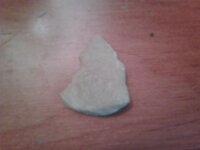BrettCo124
Hero Member
- Apr 29, 2009
- 901
- 939
- Detector(s) used
- Minelab Safari, Tesoro Sand Shark, Bazooka Gold Trap Mini, Gold Rush Nugget Bucket, Garrett Supersluice Gold Pans
- Primary Interest:
- All Treasure Hunting
Hey everyone,
Happy to have found this website. I am from Bucks County, PA. My question is,
does anyone know of my area? I live next to Pennypack Creek. I have no idea
if Indians were ever there or not, but it is a big, beautiful creek. Would this be a
place for me to start? I do not want to start in a field just yet. I am interested to
know if anyone would search any creek? Or would I just be wasting my time? I
also am confused by when people say to search for flint and other identifiable
stuff. I am unsure of how to locate that. But my main, main, main question is
what I had asked above; Is a creek always a place to discover arrowheads? I
only know that the Lenope Indians (not sure if I spelled that right) were in my
area, however people who know the creek very well told me that there were most
likely never Indian Reservations set up there. It was more for a walk way to get
from one area to another. If I go check it out, it would be best to find a creekbed
with stones all in it, right? Also, I should go after a good rainstorm? Wouldn't that
make it harder to find since the creek will rise? Another point I would have to say, is
that Pennypack Creek is subject to flooding almost every single time it rains...Is this
a bad thing and most likely will not produce anything since that happens? Or is it
the exact opposite? Sorry for all of the questions...It's just frustrating when you are
really in to a hobby but cant seem to figure out how to find anything. Basically, if I
were to go right now, I would just go over to the creek, search an area with rocks and
pebbles, and keep my fingers crossed? I have gone to this creek twice for a couple of
hours and did not find anything, but I did bring home this stone from the picture... I
know it most likely is nothing, but it is odd how it has those grooves on the side. Is
this anything?
Thanks,
Brett
Happy to have found this website. I am from Bucks County, PA. My question is,
does anyone know of my area? I live next to Pennypack Creek. I have no idea
if Indians were ever there or not, but it is a big, beautiful creek. Would this be a
place for me to start? I do not want to start in a field just yet. I am interested to
know if anyone would search any creek? Or would I just be wasting my time? I
also am confused by when people say to search for flint and other identifiable
stuff. I am unsure of how to locate that. But my main, main, main question is
what I had asked above; Is a creek always a place to discover arrowheads? I
only know that the Lenope Indians (not sure if I spelled that right) were in my
area, however people who know the creek very well told me that there were most
likely never Indian Reservations set up there. It was more for a walk way to get
from one area to another. If I go check it out, it would be best to find a creekbed
with stones all in it, right? Also, I should go after a good rainstorm? Wouldn't that
make it harder to find since the creek will rise? Another point I would have to say, is
that Pennypack Creek is subject to flooding almost every single time it rains...Is this
a bad thing and most likely will not produce anything since that happens? Or is it
the exact opposite? Sorry for all of the questions...It's just frustrating when you are
really in to a hobby but cant seem to figure out how to find anything. Basically, if I
were to go right now, I would just go over to the creek, search an area with rocks and
pebbles, and keep my fingers crossed? I have gone to this creek twice for a couple of
hours and did not find anything, but I did bring home this stone from the picture... I
know it most likely is nothing, but it is odd how it has those grooves on the side. Is
this anything?
Thanks,
Brett
Attachments
Upvote
0





 ?
?  I really want to find one, but its frustrating to wonder if I am walking a creek for 5 hours for nothing, simply because I am in the wrong spot and there is no way for one to be where I am. I want to try it again, though.
I really want to find one, but its frustrating to wonder if I am walking a creek for 5 hours for nothing, simply because I am in the wrong spot and there is no way for one to be where I am. I want to try it again, though.



